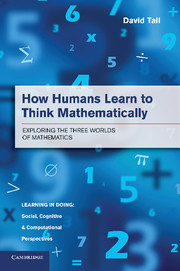Book contents
- Frontmatter
- Dedication
- Contents
- Series Foreword
- Journeys through three worlds of mathematics
- Preface
- Acknowledgements
- Illustration Credits
- I Prelude
- II School Mathematics and Its Consequences
- 2 The Foundations of Mathematical Thinking
- 3 Compression, Connection and Blending of Mathematical Ideas
- 4 Set-Befores, Met-Befores and Long-Term Learning
- 5 Mathematics and Emotion
- 6 The Three Worlds of Mathematics
- 7 Journeys through Embodiment and Symbolism
- 8 Problem Solving and Proof
- III Interlude
- IV University Mathematics and Beyond
- Appendix Where It All Came From
- References
- Index
4 - Set-Befores, Met-Befores and Long-Term Learning
from II - School Mathematics and Its Consequences
Published online by Cambridge University Press: 05 June 2014
- Frontmatter
- Dedication
- Contents
- Series Foreword
- Journeys through three worlds of mathematics
- Preface
- Acknowledgements
- Illustration Credits
- I Prelude
- II School Mathematics and Its Consequences
- 2 The Foundations of Mathematical Thinking
- 3 Compression, Connection and Blending of Mathematical Ideas
- 4 Set-Befores, Met-Befores and Long-Term Learning
- 5 Mathematics and Emotion
- 6 The Three Worlds of Mathematics
- 7 Journeys through Embodiment and Symbolism
- 8 Problem Solving and Proof
- III Interlude
- IV University Mathematics and Beyond
- Appendix Where It All Came From
- References
- Index
Summary
In this chapter, the ideas of ‘set-before’ and ‘met-before’ are employed to provide a framework for the longer-term development of mathematical thinking. A set-before is ‘a mental structure that we are born with, which may take a little time to mature as our brains make connections in early life’. As such it is a fundamental structure that is shared by all. A met-before is ‘a mental structure we have now as a result of experiences we have met before’. This will depend partly on the nature of the mathematics, and so there will be communalities between different individuals, and partly on the individual’s cognitive growth, leading to widespread differences.
In Chapter 3 we saw how mathematical concepts arise through three forms of compression: categorization, encapsulation and definition. In this chapter we relate these developments through three major ‘set-befores’ based on our sensori-motor system and our use of language. These are the sensory power of recognition through perception, the motor power of repetition of actions to routinize into mathematical operations, and the use of language to describe increasingly sophisticated concepts.
- Type
- Chapter
- Information
- How Humans Learn to Think MathematicallyExploring the Three Worlds of Mathematics, pp. 84 - 117Publisher: Cambridge University PressPrint publication year: 2013

